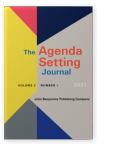Vol. 5:1 (2021) ► pp.8–30
The pictures in our heads of certain diseases
Using the network analysis method, the third level of the agenda-setting proposes that the associations between the elements on the media agenda are transferred to the public agenda. Focusing on five health issues in Turkey, this paper proposes a new perspective to third level researches. A media agenda content analysis was conducted on 13 nationwide and five local newspapers for six months and at the end of it, a public agenda survey on 400 people was conducted in Aydın, a city in Turkey. Findings show that there is a significant similarity between all the diseases chosen as a sample and taken from the newspapers and the public agenda network. The high correlation has been ranked in descending areas as: AIDS, cancer, obesity, diabetes and blood pressure. The concepts of “need for orientation” and “obtrusive and unobtrusive issues” may serve as explanations for these findings.
Article outline
- 1.Introduction
- 2.Literature review
- 3.Problem
- 4.Hypothesis
- 5.Method
- 5.1Media agenda research
- 5.2Public agenda research
- 5.3Comparison of data and calculation of QAP correlation
- 6.Findings
- Cancer
- AIDS
- Obesity
- Diabetes
- Blood pressure
- 7.Conclusion and discussion
-
References
